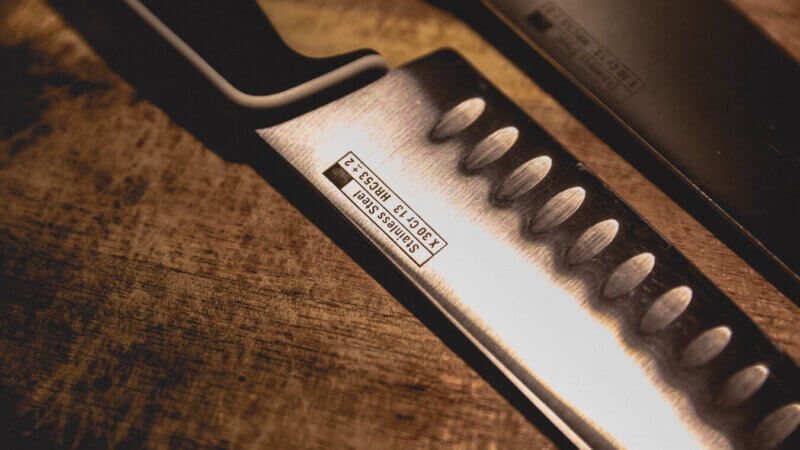Have you been accused of possession of a bladed article or offensive weapon?
A criminal offence in contravention of the Criminal Justice Act 1988 and the Prevention of Crime Act 1953, a conviction will depend on the severity of the offence, alongside any aggravating or mitigating factors.
If found guilty, sentencing ranges from a low level community order to a maximum of 4 years’ imprisonment, plus a fine.
Nick Titchener, of Lawtons Solicitors, explains this complex area of law and discusses the implications of a conviction.
What is a bladed article?
It is usually a knife, however Section 139 of the Criminal Justice Act 1988 defines a bladed article as any article that has a blade or is sharply pointed, unless it is a folding pocket knife which has a blade of less than 3 inches in length. Even a blunt butter knife with no point and no cutting edge has a blade and is therefore considered a bladed article.
What is possession of a bladed article?
Possession of a bladed article is a criminal offence in contravention of the Criminal Justice Act 1988 and – in certain circumstances – the Prevention of Crime Act 1953.
A bladed article is often classified as an offensive weapon under UK law, meaning that in certain circumstances it is illegal to carry a knife in public, even if you do not intend to use it.You are allowed to possess a bladed article in private, such as a kitchen knife at home. However, if the bladed article is used in a threatening way in this environment – as far as the law is concerned – it then becomes an offensive weapon or can be considered an assault if a person present fears an imminent attack.
What does Section 139 of the Criminal Justice Act say?
Section 139 of the Criminal Justice Act 1988 prohibits the possession of any bladed article in a public place. Section 139AA of this Act relates to an aggravated version of this offence of threatening with an article with a blade, a point or an offensive weapon.
What is the Prevention of Crime Act 1953?
Still in effect today, the Prevention of Crime Act 1953 was created to reduce violent crime by banning the possession of weapons for all civilians. In order to enforce this, it creates a clear definition of an offensive weapon, which encompasses both conventional weapons and other articles carried by civilians for purposes of violence.
What is an offensive weapon?
An offensive weapon is defined in Section One of the Prevention of Crime Act 1953 as:
‘Any article made or adapted for use to causing injury to the person, or intended by the person having it with him for such use.’
There are three categories of offensive weapon classified under UK law:
- Those made with the intent of causing harm or injury to another, including various types of knife, pepper spray and knuckle dusters
- Those adapted for the purpose of causing harm – items that have been changed or altered from their original state, such as a snooker ball in a sock, or a water pistol filled with acid
- Those carried with the intention of causing harm or injury to another, such as a bottle filled with acid carried with the intent of throwing it into someone’s face
What are the available defences for possession of an offensive weapon?
The available defences for being found in possession of an offensive weapon have been narrowly restricted by the courts. If found in possession of an offensive weapon which is classified in either of the first 2 categories, the prosecution are not required to prove the defendant was carrying the weapon with the intention to commit harm or injury.
In order to prove the third category, it is necessary for the prosecution to show that there was an intention to cause actual injury. It is not enough for the prosecution to show that there was an intention to scare or frighten, so the mere brandishing of an item would not in itself be sufficient.
If the court is satisfied that the item used is an offensive weapon the defendant would normally only be acquitted of the offence if they successfully claim the defence of lawful authority or reasonable excuse, such as:
- If the knife is a tool of your trade, such as a Stanley knife or a chef’s knife
- For religious reasons, such as a Sikh kirpan
In self-defence, if the threat of violence is imminent and the possession of the offensive weapon is more than just a precautionary measure.
Which knives are illegal under UK law?
Several types of knife are automatically illegal – with no exceptions – under UK law, including:
- Flick knives – also known as ‘switchblades’ where the blade is hidden but shoots out when a button is pressed and then locks into place
- Butterfly knives – where the blade is hidden inside a handle that splits into two around it
- Disguised knives – where the blade is hidden inside something such as a belt
- Sword-sticks
- Samurai swords – unless the item is regarded as decorative, antique or an ornamental object
Possession of a bladed article and the law
Under UK law, the offence of possession of a bladed article is triable either way, meaning it can be heard in either the magistrates’ court or the Crown Court.
If the magistrates decide the offence can be dealt with using their sentencing powers, the accused may opt to have the case heard summarily in the magistrates’ court or on indictment – trial by jury – in the Crown Court.
What are the sentencing guidelines for possession of a bladed article?
In 2018, the Sentencing Council issued new guidelines.
These guidelines specify a range of penalties if found guilty of possession of a bladed article. The courts are increasingly imposing harsher and longer sentences for those people convicted or pleading guilty to offences involving knives or offensive weapons.
If found guilty of the offence, the penalty or sentence will depend on various factors including:
- The severity of the offence – culpability and harm
- Any aggravating factors
- Any mitigating factors
What happens to a first time offender carrying a knife?
If pleading not guilty and the offence is a first offence, the starting points and category ranges will be:
| Harm | Starting Point – Category A | Starting Point – Category B | Starting Point – Category C | Starting Point – Category D |
| Category 1 | 18 months’ imprisonment | 9 months’ imprisonment | 3 months’ imprisonment | High level community order |
| Category range – Category A | Category range – Category B | Category range – Category C | Category range – Category D | |
| 12 months’ – 30 months’ imprisonment | 6 months’ – 18 months’ imprisonment | High level community order – 6 months’ custody | Mid-level community order – 3 months’ custody | |
| Category 2 | Starting Point – Category A | Starting Point – Category B | Starting Point – Category C | Starting Point – Category D |
| 6 months’ imprisonment | High level community order | Mid-level community order | Low-level community order | |
| Category range – Category A | Category range – Category B | Category range – Category C | Category range – Category D | |
| 3 months’ – 12 months’ imprisonment | Mid-level community order – 6 months’ imprisonment | Low-level community order – high-level community order | Band C fine – mid-level community order |
What is the definition of a category 1 offence?
A category 1 offence indicates a higher level of harm. Factors considered in order to determine the level of harm caused include:
- If the offence was committed at a school or other place where vulnerable people are present
- If the offence was committed in prison
- If the offence was committed in circumstances where there was a risk of serious disorder
- If the offence caused serious distress or alarm
What is the definition of a category 2 offence?
A category 2 offence is classified as any other offence that does not fall within category 1.
Aggravating factors in a case of possession of a bladed article
In a case of possession of a bladed article, factors which indicate a higher level of culpability or a greater degree of harm will be considered when sentencing.
Factors which indicate a higher level of culpability include:
- Any previous convictions relating to the offence
- The offence was committed whilst on bail
- The use of a particularly dangerous weapon
- The intentional, planned use of the weapon to commit violence, threaten violence or intimidate
- If attempts were made to conceal identity
- If attempts were made to conceal or dispose of evidence
- If the offence was motivated by hostility towards a minority individual or group
- If the offence was committed under the influence of drink or drugs
- If the offender was operating in a group or gang
Factors which indicate a greater degree of harm include:
- The offence was committed at a school, hospital or other place where vulnerable persons may be present
- The offence was committed on premises where people carry out public services
- The offence was committed on licensed premises
- The offence was committed on public transport
- The offence was committed at a large public gathering, especially where there may be risk of disorder
Mitigating factors in a case of possession of a bladed article
Factors indicating lower culpability include:
- If the weapon was originally in the defendant’s possession for a legitimate reason, such as in the course of their work
- If the weapon was only carried on a temporary basis
When sentencing, mitigating factors which may also be taken into account include:
- Showing genuine remorse
- No previous convictions
- A willingness to cooperate with police
- Admission during a police interview
- Good character
- A lack of maturity
- A mental disorder or learning disability
- A serious medical condition requiring intensive or long term treatment
- If the defendant is the sole or primary carer for dependants
When tried summarily in the magistrates’ court, the maximum penalty for being found guilty of possession of a bladed article is a level 5 fine and/or 6 months in prison.
When tried on indictment in the crown court, the maximum penalty is 4 years’ imprisonment.
If there is a previous conviction for being in possession of a bladed article, the court must impose a minimum custodial sentence of 6 months unless it considers it unjust to do so. This change in the law reflects how the courts are increasingly sentencing knife crime more harshly and imposing deterrent sentences, which is why expert legal advice and assistance is so important.
The court may also impose an ancillary order or compensation.
What to do if you are accused of possession of a bladed article
If you have been accused of possession of a bladed article, you should seek expert legal advice as soon as you are able to do so. Expert representation is essential to ensure the best possible outcome for your case.
Having a legal team that can support you is vital. At Lawtons our specialist serious violence and assault solicitors are experienced in defending the most complex legal cases. We will work with you to establish the facts of the case with the aim of achieving the best outcome for you, whilst minimising the potential impact on your reputation.
Call us on 0333 577 0522 to discuss the individual circumstances of your case.
Note: This guide is intended to give general information only and not intended to be used as the basis upon which advice is given nor should it be relied upon as giving advice specific to a case or individual.
Lawtons do not accept liability for anyone using this guide. Should you require specific advice in connection with a real case or situation, please contact us so we can provide specific legal advice and assistance.
About the author
Nick Titchener, director Lawtons, is a criminal solicitor with vast experience in the most serious legal cases. His measured, methodical approach to his work means that he thrives on complex cases including sexual offences, violence and assault.
Nick also helps to oversee the overall management of Lawtons Solicitors, a specialist firm of criminal law defence solicitors with branches in London, Hertfordshire, Bedfordshire and Essex.
This guide is only intended to provide general advice and should not be relied upon as providing specific advice in relation to individuals or cases. The law is complex and specialist advice is required in relation to specific circumstances or cases.
Lawtons Solicitors Ltd accept no liability for anyone relying upon or seeking to interpret this blog. Should you require specific advice or assistance, please contact us to discuss your case.
FAQs about Possession of Offensive Weapons
What is the minimum sentence for carrying a knife?
Is it illegal to carry a knife in your car?
Are Swiss Army knives legal in the UK?
Is it illegal to carry a screwdriver in public?





